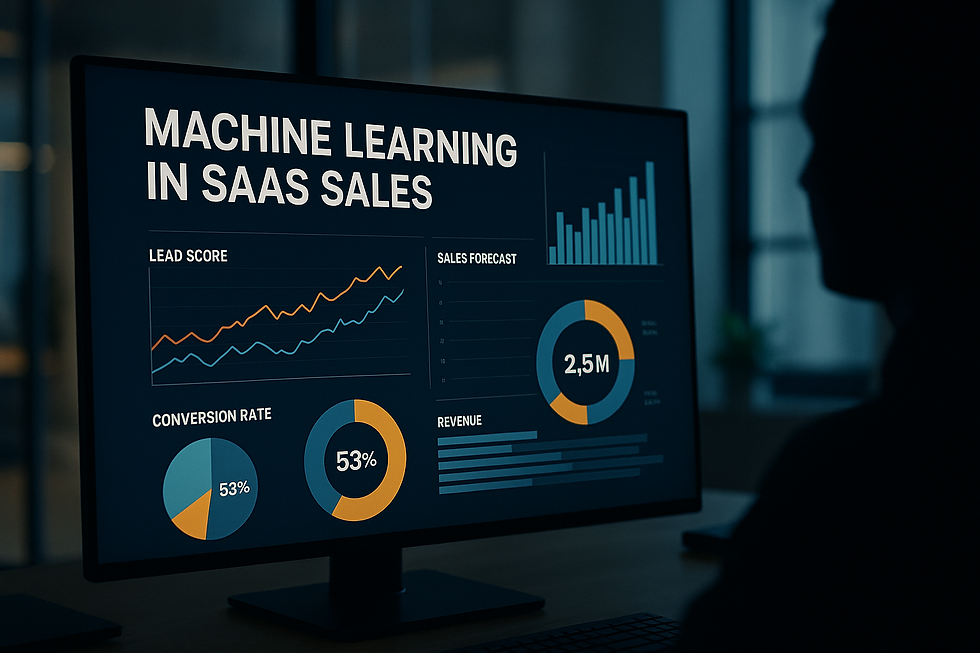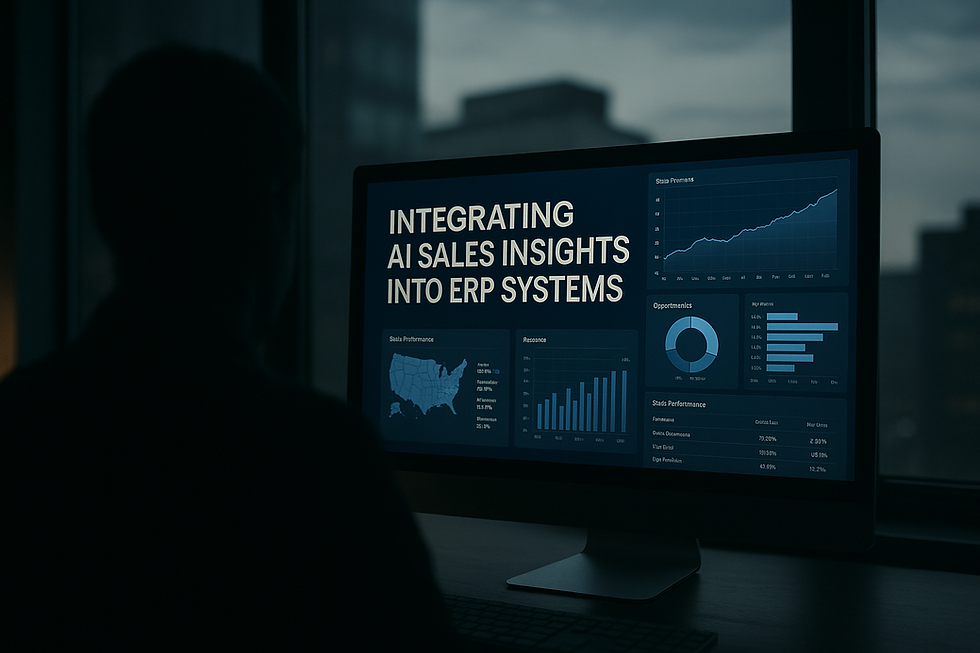How Machine Learning Improves Sales Performance—and Fixes Missed Targets
- Muiz As-Siddeeqi

- Aug 22
- 5 min read

How Machine Learning Improves Sales Performance—and Fixes Missed Targets
Sales teams around the world aren’t just battling competitors anymore. They're battling uncertainty, information overload, and performance fatigue. Targets are missed—not because reps are lazy or strategies are weak—but because the battlefield has changed. And the old tactics? They simply don’t win modern wars anymore.
Let’s say it loud: Sales today isn’t about just making more calls, chasing more leads, or pushing harder with outdated playbooks.
It’s about smarter strategies. Predictive insights. Real-time intelligence. It's about machine learning to improve sales performance at every step—from finding high-intent prospects to closing deals faster and retaining customers longer.
And that’s exactly where ML is stepping in—not with vague promises or futuristic hype—but with real, documented transformations that are already reshaping sales outcomes across industries right now.
Bonus: Machine Learning in Sales: The Ultimate Guide to Transforming Revenue with Real-Time Intelligence
The Harsh Truth: Why Sales Teams Keep Missing Targets
Only 24.3% of salespeople exceeded their quota in 2023, according to the 2024 Sales Performance Study by Sales Insights Lab.
According to Gartner, 62% of B2B sales reps say they are overwhelmed by too much information, and lack insights that are truly actionable.
CSO Insights found that 53% of sales reps failed to hit their quotas in 2022, and this stat has hardly improved post-pandemic.
So why is this happening?
Despite tech stacks getting heavier, and pipelines looking fancier—revenue targets are still missed. Repeatedly.
The truth? Most companies still rely on outdated dashboards, manual forecasts, gut-feeling-based lead scoring, and generic outreach campaigns. In a world where buyer behavior is complex, digital, and ever-changing, this approach is setting up sales teams to fail.
Enter Machine Learning: Not Buzz. Real Results.
Machine learning isn’t just a buzzword tossed into sales decks. It’s a set of real mathematical models and algorithms—trained on your sales data—that learn, adapt, and improve over time. It finds patterns no human could catch, predicts behaviors, scores leads, and tells reps what to prioritize—all in real-time.
Let’s not talk theory. Let’s talk data, documented use cases, and results.
What Does ML Actually Do for Sales Teams?
Here’s how machine learning is directly improving sales performance and fixing missed targets, right now, across real organizations:
1. Predicting Buyer Intent with Shocking Accuracy
According to Forrester Research, companies using AI and ML for intent prediction see conversion rates increase by up to 50%.
ML models analyze behavioral signals like:
Email opens
Page visits
Demo views
Scroll depths
Time spent on pricing pages
Then they predict who’s most likely to convert next week—and who’s likely to ghost.
Real Example:6sense, a B2B revenue intelligence platform, used machine learning to increase pipeline generation by 25% for Snowflake. Their ML engine identified in-market accounts that reps would have otherwise missed entirely.
[Citation: 6sense Case Study, 2023]
2. Lead Scoring Based on Probability, Not Guesswork
Traditional lead scoring is static and rules-based. But machine learning scoring adapts. It learns what types of leads actually convert at your company and updates the score in real-time based on every new datapoint.
Real-World Result:HubSpot's AI-powered predictive lead scoring engine led to 35% improvement in MQL-to-SQL conversion for B2B SaaS clients.
[Citation: HubSpot AI Lead Scoring Case Study, 2023]
3. Sales Forecasting That's (Finally) Accurate
IBM found that their Watson-powered sales forecasting system was 29% more accurate than traditional spreadsheet-based forecasting.
Instead of relying on reps to update CRMs (which 40% don’t do accurately according to Salesforce), ML automatically analyzes:
Email sentiment
Call transcripts
Deal progression
Historical patterns
…and predicts which deals will close, and when. No more wishful forecasts.
[Citation: IBM Watson Forecasting Case Study, 2022]
4. Dynamic Pricing and Discount Optimization
You’re losing money in deals without knowing it.
McKinsey found that companies using ML for price optimization saw up to 8% increase in revenue and 5-10% increase in margin.
ML adjusts pricing and discount recommendations in real-time, based on:
Customer type
Order size
Industry benchmarks
Historical deal win/loss data
Real Example:
PROS, an ML-based pricing platform, helped Lufthansa Cargo optimize dynamic pricing and boosted revenue by 3%, with real-time ML pricing models.
[Citation: PROS + Lufthansa Case Study, 2023]
5. Churn Prediction and Customer Retention
The sale isn’t over when the deal is signed. And ML knows this.
Zendesk reported that churn prediction models helped their clients reduce customer attrition by 20-30%, by identifying customers likely to churn 30–60 days ahead of time.
It looks at:
Declining product usage
Negative support tickets
Billing pauses
Social sentiment
Login frequency
…and alerts customer success or sales to intervene proactively.
[Citation: Zendesk CX Trends Report, 2023]
Without Machine Learning, Here's What You're Missing
Let’s be blunt: if your sales team isn’t using ML, you’re leaving money—lots of it—on the table.
You’re:
Chasing bad leads.
Relying on biased rep data.
Using outdated forecasts.
Over-discounting.
Missing high-risk churn customers.
Losing to competitors who are already using ML.
The Sales Stack Is Broken. ML Is the Mortar That Fixes It.
Most sales stacks today are cluttered, siloed, and inefficient. CRMs are bloated. Reps are drowning in data. Managers are making decisions on incomplete dashboards.
Here’s what machine learning integrates and improves across the stack:
CRM: Real-time updates, dynamic lead scoring
Sales Enablement Tools: Recommends next-best content and messaging
Revenue Intelligence Platforms: Predicts pipeline risk
Email and Call Intelligence: Analyzes sentiment and follow-up urgency
Marketing Automation: Aligns campaigns with actual buyer behavior
This is sales alignment with machine intelligence—and it’s no longer optional.
Real Case Studies from the Field (All Documented)
Intuit (QuickBooks)
Problem: 200+ sales reps missing monthly upsell targets.
Solution: Used ML to analyze past upsell success across industry, business size, and usage behavior.
Result: Reps received prioritized upsell recommendations and boosted add-on revenue by 22% in 9 months.
[Citation: Intuit AI Insights, TechCrunch, 2022]
ZoomInfo
Problem: Low outbound conversion rates despite massive data.
Solution: Deployed ML to refine ideal customer profile (ICP) dynamically based on real-time conversion success.
Result: Outbound performance increased by 30%, and cost per opportunity dropped by 27%.
[Citation: ZoomInfo Quarterly Report, Q1 2023]
Adobe
Problem: Forecast misses of 15–25% across enterprise sales.
Solution: Trained ML models to predict deal velocity, contract value, and close likelihood.
Result: Sales forecast accuracy improved by 35%, pipeline predictability improved drastically.
[Citation: Adobe Digital Experience Blog, 2023]
How You Can Start (Even Without a Data Scientist)
ML isn’t only for Fortune 500s. Here’s how even small and mid-sized businesses are starting:
Start with one use case: Lead scoring, churn prediction, or sales forecasting.
Use ML-ready tools:
Feed clean CRM data: Even the best models fail if your CRM is messy.
Monitor continuously: Machine learning improves with time—track precision, recall, and ROI.
Don’t over-automate: Let ML augment reps, not replace them.
Final Word: You Don't Need More Hustle. You Need Machine Learning.
Your sales team doesn’t need another pep talk. They need precision. Prediction. Performance.
They need:
ML telling them which lead is gold—and which one is noise.
ML showing when the deal will close—and how to push it forward.
ML warning which client might leave—and how to save them.
This isn’t futuristic. This is now.
And the companies that are embracing machine learning in their sales operations?
They’re not just hitting targets—they’re resetting them.
TL;DR Key Takeaways
Machine learning in sales is no longer optional—it's critical for performance.
ML improves everything from lead scoring and forecasting to retention and pricing.
Real companies like Adobe, ZoomInfo, HubSpot, Intuit, and Lufthansa are using it and getting measurable results.
Sales teams that rely on old methods are falling behind—fast.

$50
Product Title
Product Details goes here with the simple product description and more information can be seen by clicking the see more button. Product Details goes here with the simple product description and more information can be seen by clicking the see more button

$50
Product Title
Product Details goes here with the simple product description and more information can be seen by clicking the see more button. Product Details goes here with the simple product description and more information can be seen by clicking the see more button.

$50
Product Title
Product Details goes here with the simple product description and more information can be seen by clicking the see more button. Product Details goes here with the simple product description and more information can be seen by clicking the see more button.






Comments